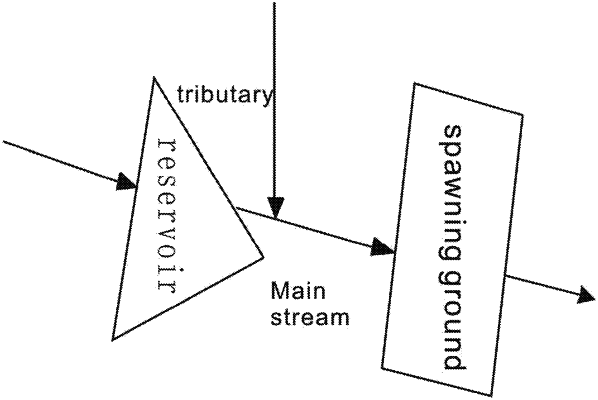| CPC E02B 3/02 (2013.01) [E02B 1/02 (2013.01)] | 5 Claims |

|
1. A main stream reservoir ecological modulation method considering incoming water from interval tributaries, comprising the following steps:
Step 1 of determining a contribution ratio of the incoming water from interval tributaries to first-day's water rising in a high-flow surge process and when to start ecological modulations of spawning ground sections, wherein Step 1 specifically comprises the following sub steps:
(1) determining target fish's ecological and hydrological parameters of spawning ground sections, according to target fish's spawning monitoring data of spawning grounds and hydrological data, determining target fish's ecological and hydrological parameters of spawning ground controlled sections, that is, determining values of a rising flow Qe, an initial increase of water levels Ze, a peak flow Qm, an average flow increase dQ, and a duration of water rising D;
(2) calculating the contribution ratio of the incoming water from interval tributaries to the first-day's water rising in a high-flow surge process, according to hydrological runoff data of the tributaries, calculating a frequency of high-flow surge processes in downstream spawning grounds, analyzing an influence of the incoming water from an upstream main stream and interval tributaries on the high-flow surge processes in downstream spawning grounds, determining a contribution ratio β of the incoming water from interval tributaries to the first-day's water rising in the high-flow surge process of spawning grounds;
(3) determining when to start ecological modulations, according to the hydrological runoff data of controlling stations at a main stream and its tributaries, simulating a high-flow surge generation process by an IHA method, in a case that the contribution ratio β of the incoming water from interval tributaries to the first-day's water rising in the high-flow surge process of spawning grounds is greater than a threshold θ during fish spawning, selecting the rising flow Qe, the average flow increase dQ, and the duration of water rising D of interval tributaries as control indexes for starting ecological modulations, thus a starting time st for starting ecological modulations being judged according to a process of the water rising of and the incoming water from tributaries; in a case that the contribution ratio β of the incoming water from interval tributaries to the first-day's water rising in the high-flow surge process of spawning grounds is not greater than a threshold θ during fish spawning, selecting the rising flow Qe, the average flow increase dQ, and the duration of water rising D of a main stream as control indexes for starting ecological modulations, thus the starting time st for starting ecological modulations being judged according to the water rising of a main stream;
Step 2 of determining a river course routing method after a main stream and its tributaries joining and calibrating parameters, based on hydrological data, performing river flow calculation on a discharge volume of upstream reservoirs and a flow after interval tributaries joining, taking into account an inflow of other small tributaries, performing river flow calculation by a Muskingen model considered with an inflow of side branches;
Step 3 of determining a main stream reservoir ecological modulation mode considering incoming water from interval tributaries, wherein Step 3 specifically comprises the following sub steps:
(1) building a high-flow surge frequency simulation model of spawning ground sections, according to a high-flow surge composition of spawning ground sections and the contribution ratio of the incoming water from interval tributaries to the first-day's water rising in the high-flow surge process, determining a main stream reservoir ecological modulation mode, so as to maximize an artificial high-flow surge frequency H, that is, max|H|, where H is the determined high-flow surge frequency of spawning ground-controlled sections calculated by the ecological modulation method considering incoming water from interval tributaries;
(2) determining the ecological modulation mode of the main stream reservoir coordinated to the interval incoming water, in order to coordinate to the interval incoming water to make the high-flow surge frequency H of the controlled section as large as possible, solving an outflow process of the main stream reservoir through optimization, and an outflow Qoutst+j+1 of the main stream reservoir during st+j+1 period being deduced as Formula (3),
Qsyst+j+1=d0(Qoutst+j+1Qmjst+j+1)+d1(Qoutst+j+Qmjst+j)+d2Qsyst+1Qoutst+j+1=(Qsyst+j+1−d1(Qoutst+j+Qmjst+j)−d2Qsyst+j)/d0−Qmjst+j+1 (3)
where Qsyst+j refers to a composite flow of the spawning ground controlled section, Qmjst+j refers to the flow of interval tributaries, and st is a starting period of ecological modulations, which is determined by water rising of a main stream or interval tributaries, that is, during fish spawning period β>θ in a case that a water rising process with a continuous water rising process for not less than D days, an average flow increase of not less than dQ, and a corresponding rising flow of not less than Qe occurs at a forecasted interval tributary, a main stream reservoir starts an ecological compensation modulation considering interval incoming water on a first day of interval water-rising, during β≤θ in a case that a water rising process with a continuous water rising process for not less than D days, an average flow increase of not less than dQ, and a corresponding rising flow of not less than Qe occurs at a forecasted main stream, a main stream reservoir starts an ecological compensation modulation considering interval incoming water on a first day of main stream water-rising.
|